tow TOYOTA PRIUS PLUG-IN 2013 User Guide
[x] Cancel search | Manufacturer: TOYOTA, Model Year: 2013, Model line: PRIUS PLUG-IN, Model: TOYOTA PRIUS PLUG-IN 2013Pages: 704, PDF Size: 19.59 MB
Page 272 of 704
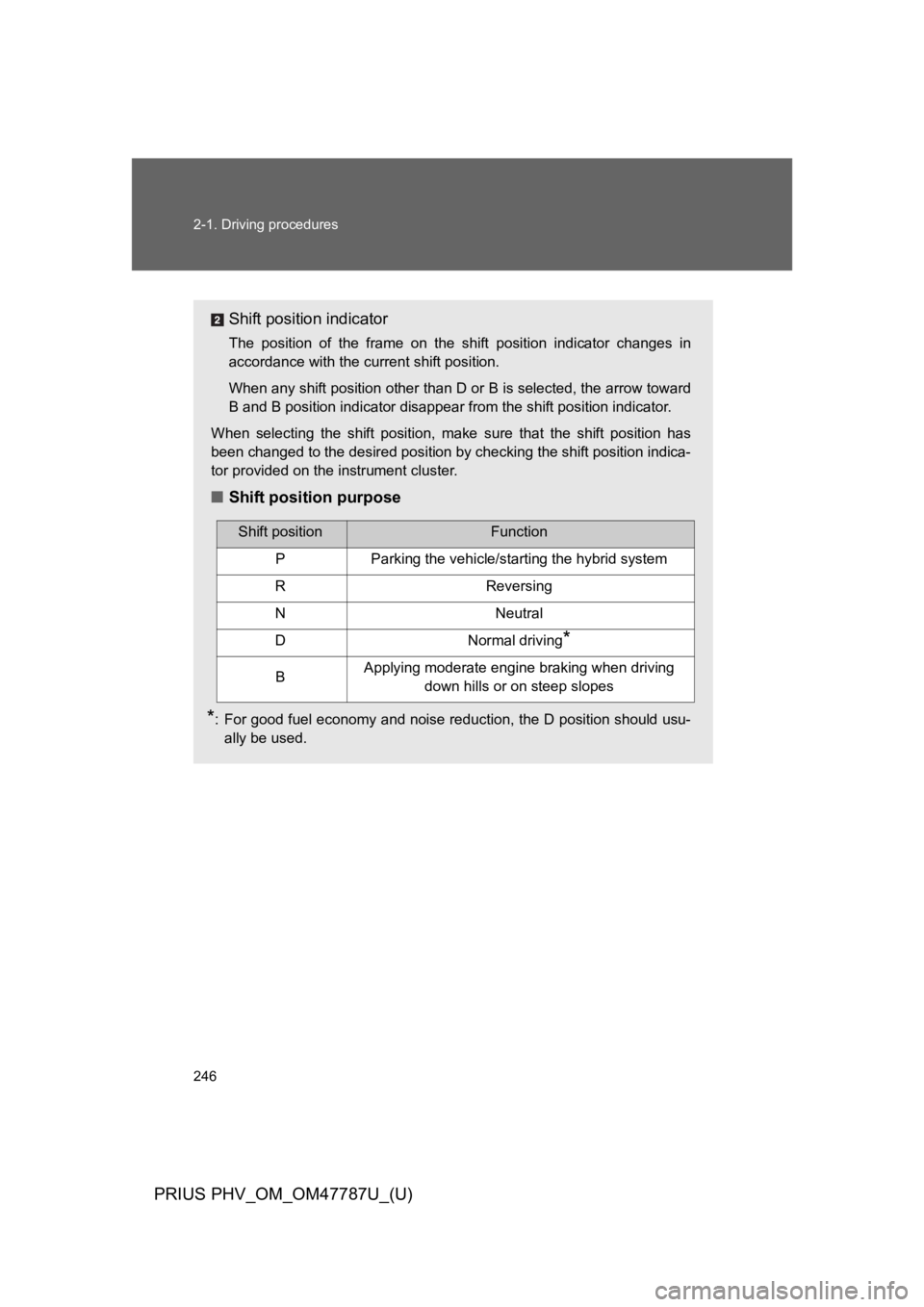
246
2-1. Driving procedures
PRIUS PHV_OM_OM47787U_(U)
Shift position indicator
The position of the frame on the shift position indicator changes in
accordance with the current shift position.
When any shift position other than D or B is selected, the arrow toward
B and B position indicator disappear from the shift position indicator.
When selecting the shift position, make sure that the shift position has
been changed to the desired position by checking the shift position indica-
tor provided on the instrument cluster.
■Shift position purpose
*:For good fuel economy and noise reduction, the D position should usu-
ally be used.
Shift positionFunction
PParking the vehicle/starting the hybrid system
RReversing
NNeutral
DNormal driving*
BApplying moderate engine braking when driving
down hills or on steep slopes
Page 321 of 704
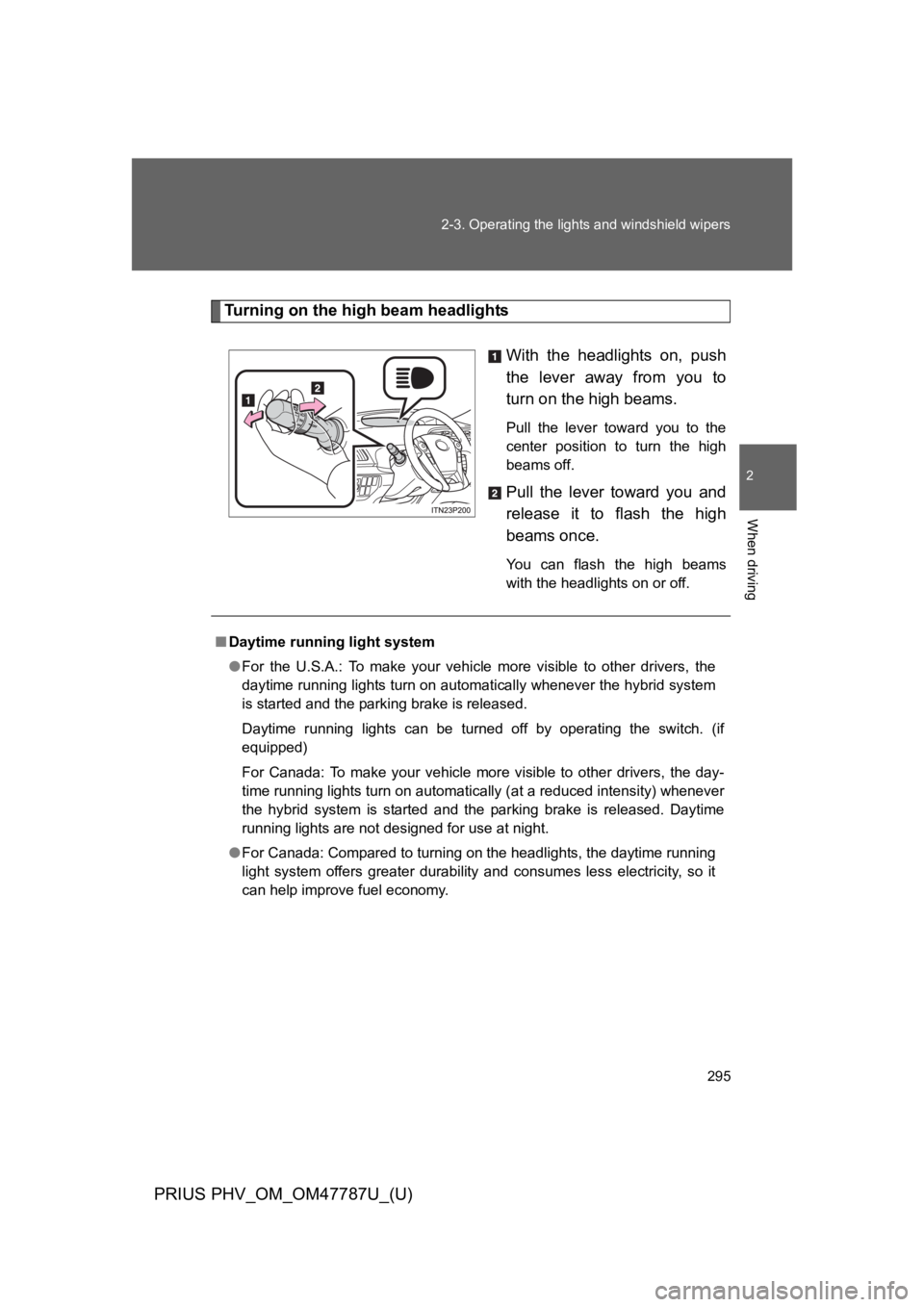
295
2-3. Operating the lights and windshield wipers
PRIUS PHV_OM_OM47787U_(U)
2
When driving
Tu r n i n g o n t h e h i g h b e a m h e a d l i g h ts
With the headlights on, push
the lever away from you to
turn on the high beams.
Pull the lever toward you to the
center position to turn the high
beams off.
Pull the lever toward you and
release it to flash the high
beams once.
Yo u c a n f l a s h t h e h i g h b e a m s
with the headlights on or off.
■Daytime running light system
●For the U.S.A.: To make your vehicle more visible to other drivers, the
daytime running lights turn on automatically whenever the hybrid system
is started and the parking brake is released.
Daytime running lights can be turned off by operating the switch. (if
equipped)
For Canada: To make your vehicle more visible to other drivers, the day-
time running lights turn on automatically (at a reduced intensity) whenever
the hybrid system is started and the parking brake is released. Daytime
running lights are not designed for use at night.
●For Canada: Compared to turning on the headlights, the daytime running
light system offers greater durability and consumes less electricity, so it
can help improve fuel economy.
Page 335 of 704
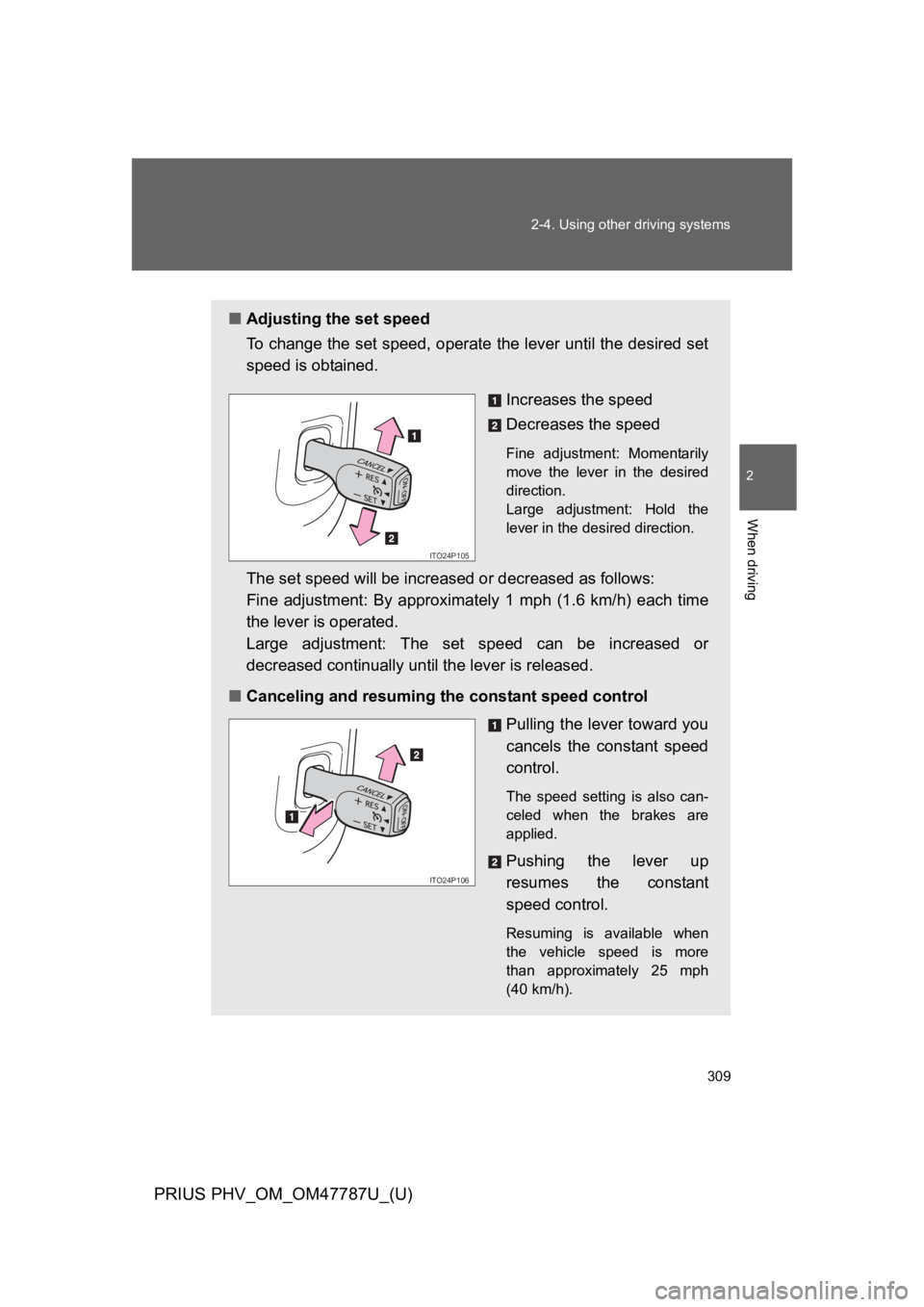
309
2-4. Using other driving systems
PRIUS PHV_OM_OM47787U_(U)
2
When driving
■Adjusting the set speed
To c h a n g e t h e s e t s p e e d , o p e r a t e the lever until the desired set
speed is obtained.
Increases the speed
Decreases the speed
Fine adjustment: Momentarily
move the lever in the desired
direction.
Large adjustment: Hold the
lever in the desired direction.
The set speed will be increased or decreased as follows:
Fine adjustment: By approximately 1 mph (1.6 km/h) each time
the lever is operated.
Large adjustment: The set speed can be increased or
decreased continually until the lever is released.
■Canceling and resuming the constant speed control
Pulling the lever toward you
cancels the constant speed
control.
The speed setting is also can-
celed when the brakes are
applied.
Pushing the lever up
resumes the constant
speed control.
Resuming is available when
the vehicle speed is more
than approximately 25 mph
(40 km/h).
ITO24P105
ITO24P106
Page 337 of 704
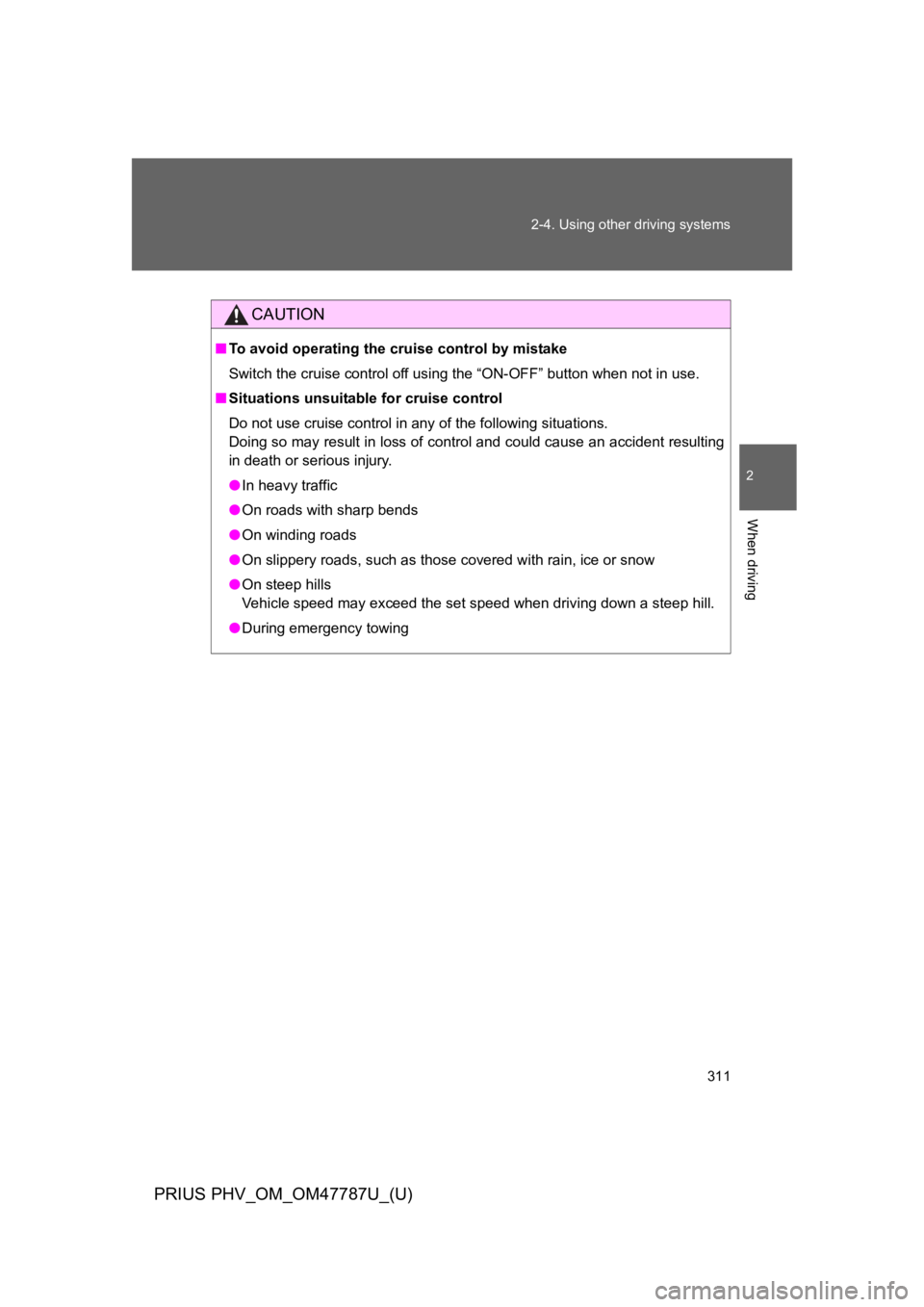
311
2-4. Using other driving systems
PRIUS PHV_OM_OM47787U_(U)
2
When driving
CAUTION
■To a v o i d o p e r a t i n g t h e c r u i s e c o n t r o l b y m i s ta k e
Switch the cruise control off using the “ON-OFF” button when not in use.
■Situations unsuitable for cruise control
Do not use cruise control in any of the following situations.
Doing so may result in loss of control and could cause an accident resulting
in death or serious injury.
●In heavy traffic
●On roads with sharp bends
●On winding roads
●On slippery roads, such as those covered with rain, ice or snow
●On steep hills
Ve h i c l e s p e e d m a y e x c e e d t h e s e t s p e e d w h e n d r i v i n g d o w n a s t e e p h i l l .
●During emergency towing
Page 342 of 704
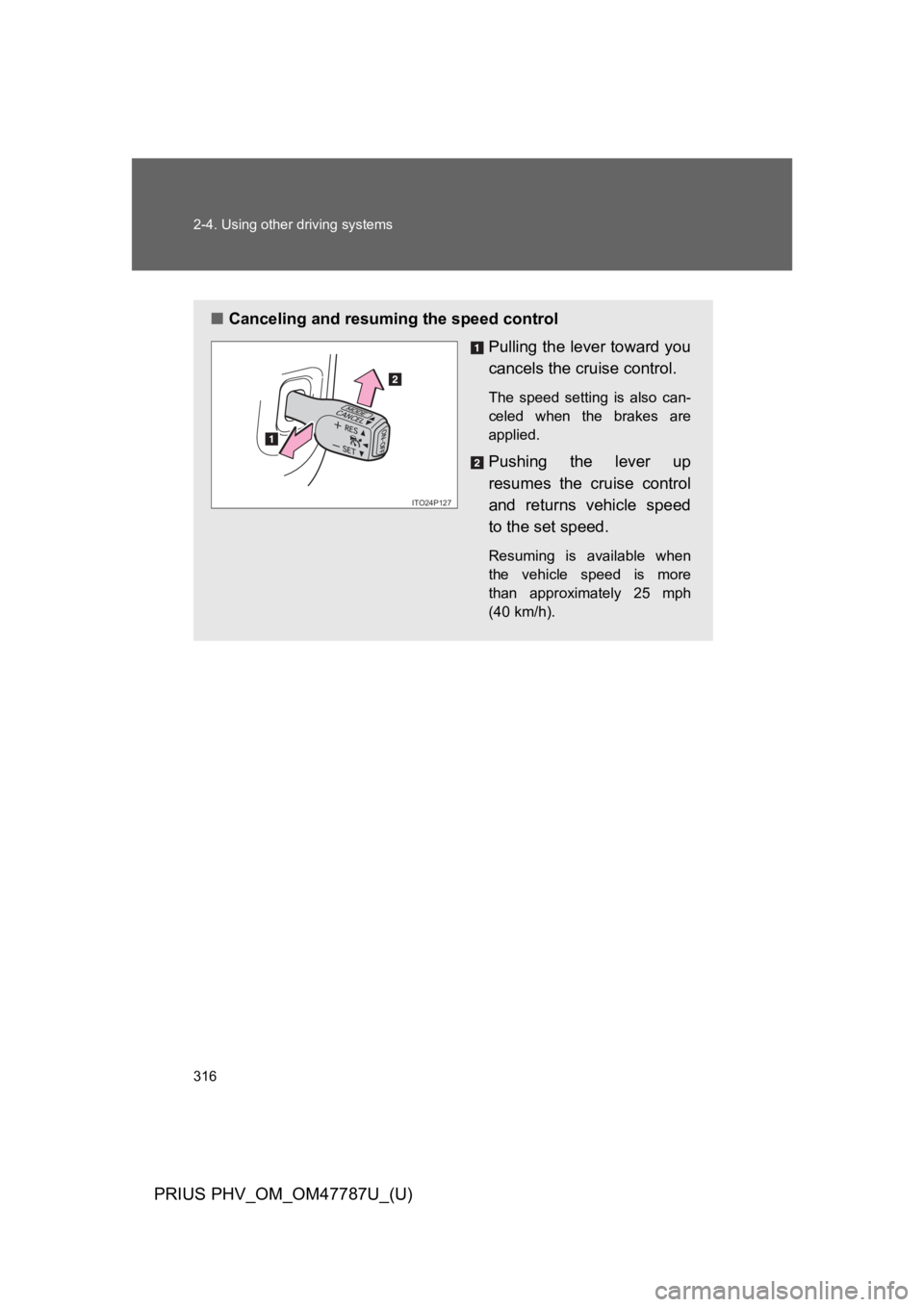
316
2-4. Using other driving systems
PRIUS PHV_OM_OM47787U_(U)
■Canceling and resuming the speed control
Pulling the lever toward you
cancels the cruise control.
The speed setting is also can-
celed when the brakes are
applied.
Pushing the lever up
resumes the cruise control
and returns vehicle speed
to the set speed.
Resuming is available when
the vehicle speed is more
than approximately 25 mph
(40 km/h).
ITO24P127
Page 351 of 704
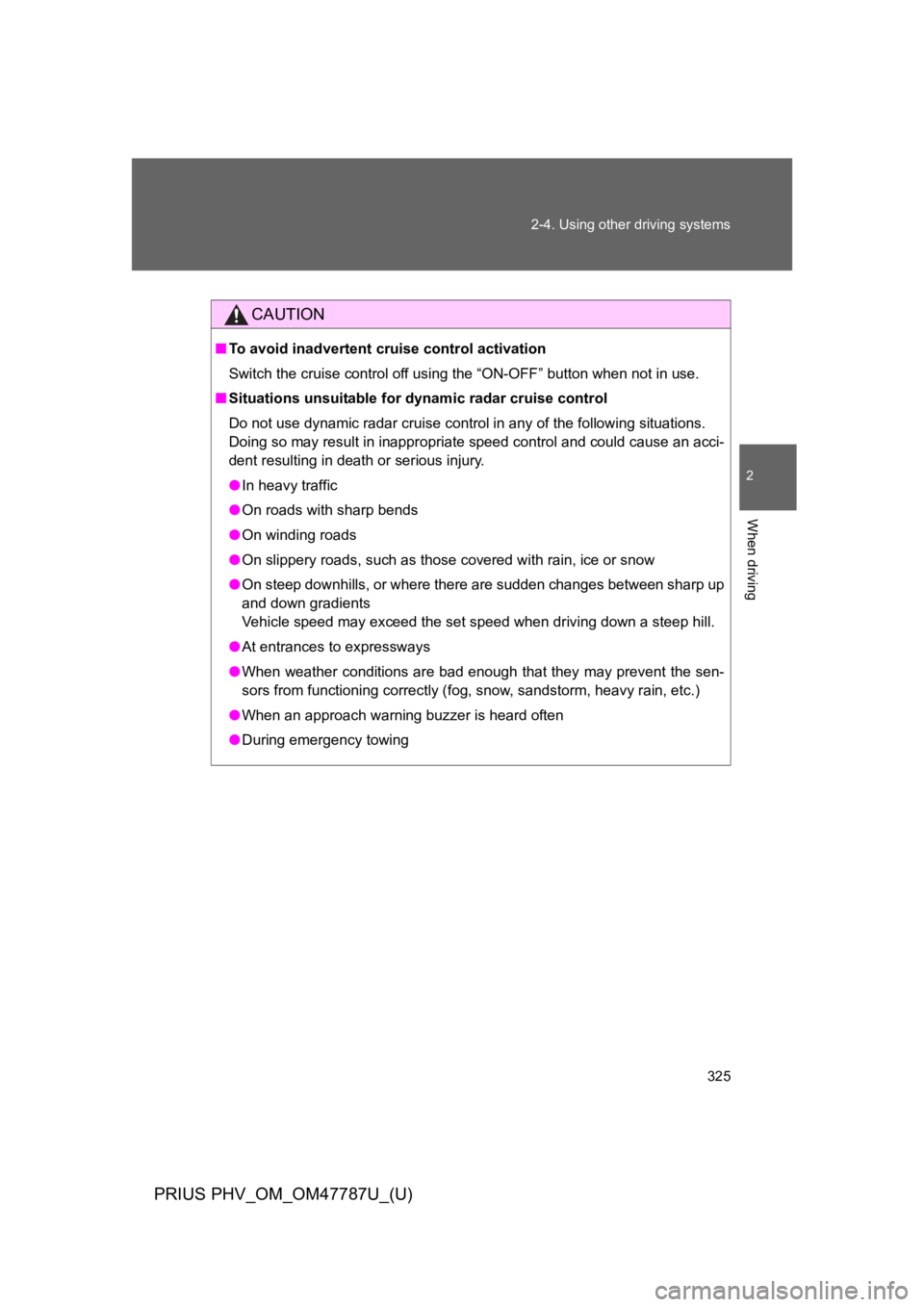
325
2-4. Using other driving systems
PRIUS PHV_OM_OM47787U_(U)
2
When driving
CAUTION
■To a v o i d i n a d v e r t e n t c ruise control activation
Switch the cruise control off using the “ON-OFF” button when not in use.
■Situations unsuitable for dynamic radar cruise control
Do not use dynamic radar cruise control in any of the following situations.
Doing so may result in inappropriate speed control and could cause an acci-
dent resulting in death or serious injury.
●In heavy traffic
●On roads with sharp bends
●On winding roads
●On slippery roads, such as those covered with rain, ice or snow
●On steep downhills, or where there are sudden changes between sharp up
and down gradients
Ve h i c l e s p e e d m a y e x c e e d t h e s e t s p e e d w h e n d r i v i n g d o w n a s t e e p h i l l .
●At entrances to expressways
●When weather conditions are bad enough that they may prevent the sen-
sors from functioning correctly (fog, snow, sandstorm, heavy rain, etc.)
●When an approach warning buzzer is heard often
●During emergency towing
Page 370 of 704

344
2-5. Driving information
PRIUS PHV_OM_OM47787U_(U)
Capacity and distribution
Cargo capacity depends on the total weight of the occupants.
(Cargo capacity) = (Total load capacity) — (Total weight of occupants)
Steps for Determining Correct Load Limit ⎯
(1) Locate the statement “The combined weight of occupants and
cargo should never exceed XXX kg or XXX lbs.” on your vehicle’s
placard.
(2) Determine the combined weight of the driver and passengers that
will be riding in your vehicle.
(3) Subtract the combined weight of the driver and passengers from
XXX kg or XXX lbs.
(4) The resulting figure equals the available amount of cargo and lug-
gage load capacity.
For example, if the “XXX” amount equals 1400 lbs. and there will
be five 150 lb passengers in your vehicle, the amount of available
cargo and luggage load capacity is 650 lbs. (1400 − 750 (5 × 150)
= 650 lbs.)
(5) Determine the combined weight of luggage and cargo being
loaded on the vehicle. That weight may not safely exceed the
available cargo and luggage load capacity calculated in Step 4.
(6) If your vehicle will be towing a trailer, load from your trailer will be
transferred to your vehicle. Consult this manual to determine how
this reduces the available cargo and luggage load capacity of
your vehicle. (→P. 3 4 8 )
To y o t a d o e s n o t r e c o m m e n d t o w i n g a t r a i l e r w i t h y o u r v e h i c l e . Yo u r
vehicle is not designed for trailer towing.
Page 372 of 704

346
2-5. Driving information
PRIUS PHV_OM_OM47787U_(U)
CAUTION
■Things that must not be carried in the luggage compartment
The following things may cause a fire if loaded in the luggage compart-
ment:
●Receptacles containing gasoline
●Aerosol cans
■Storage precautions
Observe the following precautions.
Failure to do so may result in death or serious injury.
●Stow carg o and luggage in the luggage compar tment whenever possi-
ble.
●Do not stack cargo and luggage in the luggage compartment higher
than the seatbacks.
Such items may be thrown about and possibly injure people in the
vehicle in the event of sudden braking or in an accident.
●Do not place cargo or luggage in or on the following locations as the
item may get under the brake or accelerator pedal and prevent the
pedals from being depressed properly, block the driver’s vision, or hit
the driver or passengers, causing an accident:
•At the feet of the driver
•On the front passenger or rear seats (when stacking items)
•On the luggage cover
•On the instrument panel
•On the dashboard
Page 374 of 704
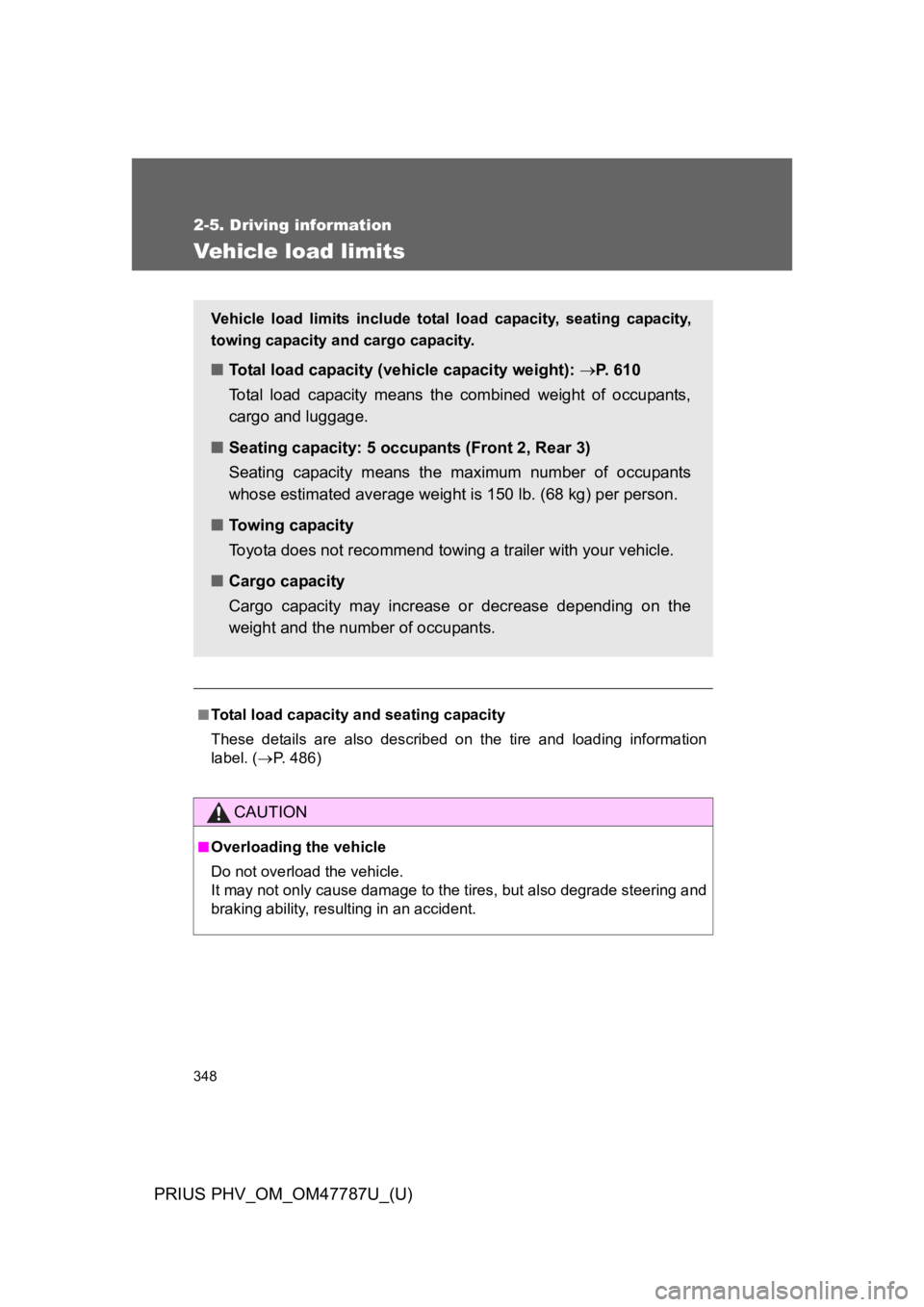
348
2-5. Driving information
PRIUS PHV_OM_OM47787U_(U)
Ve h i cl e l o a d l i m i t s
■To ta l l o a d c a pa c i t y a n d s e a t i n g c a pa c i t y
These details are also described on the tire and loading information
label. (→P. 4 8 6 )
CAUTION
■Overloading the vehicle
Do not overload the vehicle.
It may not only cause damage to the tires, but also degrade steering and
braking ability, resulting in an accident.
Ve h i c l e l oa d l i m i ts i n c l u d e t o ta l l o a d c a pa c i t y, s e a t i ng c a pa c i t y,
towing capacity and cargo capacity.
■To ta l l o a d c a pa c i t y ( v e h i c l e c a pa c i t y w e i g h t ) : →P. 6 1 0
To t a l l o a d c a p a c i t y m e a n s t h e c o m b i n e d w e i g h t o f o c c u p a n t s ,
cargo and luggage.
■Seating capacity: 5 occupants (Front 2, Rear 3)
Seating capacity means the maximum number of occupants
whose estimated average weight is 150 lb. (68 kg) per person.
■To w i n g c a pa c i t y
To y o t a d o e s n o t r e c o m m e n d t o w i n g a t r a i l e r w i t h y o u r v e h i c l e .
■Cargo capacity
Cargo capacity may increase or decrease depending on the
weight and the number of occupants.
Page 380 of 704
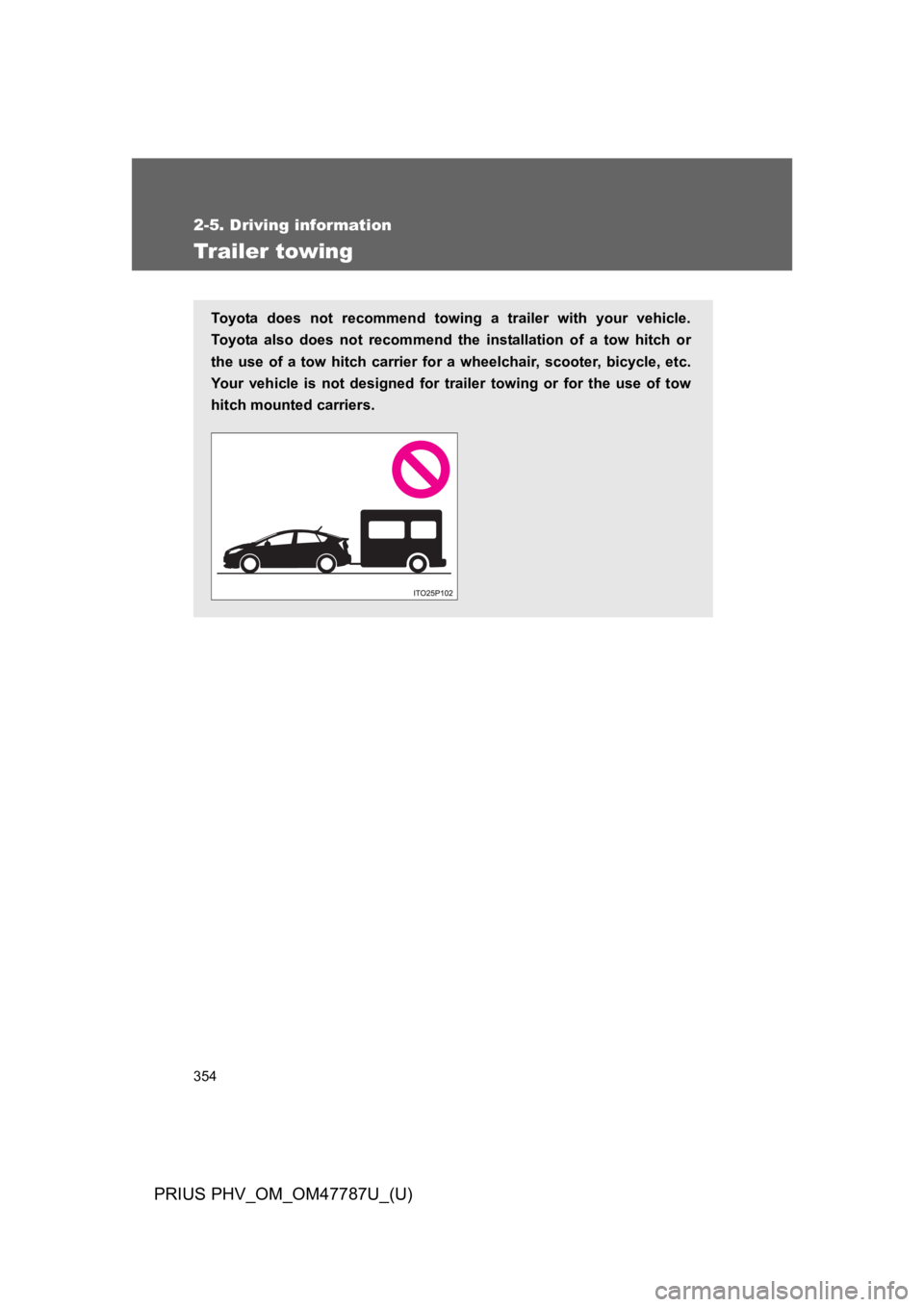
354
2-5. Driving information
PRIUS PHV_OM_OM47787U_(U)
Tr ailer towing
To y o ta d o e s n o t r e c o m m e n d t o w i n g a trailer with your vehicle.
To y o ta a l s o d o e s n o t r e c o m m e n d t h e i n s ta l l a t i o n o f a t o w h i t c h o r
the use of a tow hitch carrier for a wheelchair, scooter, bicycle, etc.
Yo u r v e h i c l e i s n o t d e s i g n e d f o r t railer towing or for the use of tow
hitch mounted carriers.